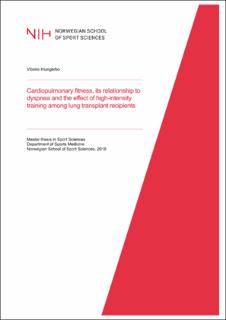| dc.description.abstract | Background: Cardiorespiratory fitness (CRF) remains low after lung transplantation (LTx) despite improvement in pulmonary function. The knowledge about the association to dyspnea is unclear and the effect of high-intensity training (HIT) has so far not been investigated in this group.
Aims: To study the effect of a 20-week HIT program on peak oxygen uptake (VO2peak), as our primary outcome, and pulmonary function. In addition, we want to evaluate VO2peak and pulmonary function at least six months after LTx, and to investigate the association to dyspnea.
Methods: In a randomized controlled trial, bilateral LTx recipients (age 20-67 years) underwent pulmonary function tests, for measurements of forced vital capacity (FVC), forced expiratory volume in one second (FEV1), diffusing capacity of the lung for carbon monoxide (DLCO), total lung capacity (TLC) and maximum voluntary ventilation (MVV). VO2peak was assessed by a maximal treadmill exercise test, and dyspnea was evaluated with the modified Medical Research Council (mMRC) dyspnea score. The association between FEV1, DLCO, VO2peak and dyspnea were assessed by Spearman’s correlation coefficient. All patients were randomized to either HIT or usual care. The exercise training was individually tailored one to one, and consisted of high intensity endurance- and resistance training, with three sessions per week for 20 weeks.
Results: Forty-eight LTx recipients completed post-transplant measurements 29±16 months after LTx. Pulmonary function were within normal limits for FVC (8921% pred), FEV1 (80±24% pred), TLC (90±15% pred) and MVV (93±23% pred), whereas DLCO was impaired (66±15% pred). VO2peak, adjusted for weight (mL∙kg-1∙min-1), was 6515% of predicted. There was a moderate correlation between VO2peak and FEV1 (r=0.555, p<0.001), between VO2peak and dyspnea (r=-0.437, p=0.002) and between FEV1 and dyspnea (r=-0.316, p=0.030). Twenty-one patients completed the exercise training intervention. Intention-to-treat analysis showed that the exercise group had a greater increase in the absolute VO2peak in % of predicted (between-group difference of 5.1 in percent of predicted, p=0.035). There were no significant between-group differences in change in pulmonary function; FVC (p=0.253), FEV1 (p=0.450), DLCO (p=0.331) and MVV (p=0.844).
Conclusion: The LTx recipients demonstrated a low cardiorespiratory fitness, despite an almost normalized pulmonary function. The associations between pulmonary function, VO2peak and dyspnea were moderate. HIT induced improvements in VO2peak. Further investigations with a sufficient sample size are needed to elucidate the effect of high intensity training in lung transplant recipients. | nb_NO |
